A rainwater capturing green roof efficiently collects and filters rainwater, reducing stormwater runoff and easing the burden on urban drainage systems. The vegetation and substrate layers naturally absorb and retain water, promoting sustainable water management. This eco-friendly solution enhances building insulation while contributing to groundwater recharge and urban cooling.
Introduction to Rainwater Capturing Green Roofs
Rainwater capturing green roofs integrate vegetation layers with advanced waterproofing and drainage systems to collect and store rainwater efficiently. These systems reduce stormwater runoff, improve water quality, and support sustainable urban water management. Incorporating native plants enhances biodiversity while maximizing rainwater absorption and retention on the rooftop.
How Rainwater Harvesting Enhances Green Roof Performance
Rainwater harvesting significantly improves green roof performance by providing a sustainable water source that supports plant health and reduces irrigation needs. Captured rainwater helps maintain optimal moisture levels, promoting vegetation growth and enhancing the roof's ability to manage stormwater runoff. This process decreases urban flooding risks while contributing to energy savings through natural cooling effects.
Essential Components of Rainwater Capturing Roof Systems
Rainwater capturing roof systems rely on key components such as a waterproof membrane to prevent leakage, a collection surface typically made from durable roofing materials, and a gutter system that channels water into storage tanks or infiltration areas. Filters and first-flush diverters are essential to remove debris and contaminants, ensuring clean water is stored for irrigation or non-potable uses. Properly designed downspouts and storage tanks complete the system, optimizing rainwater harvesting efficiency and sustainability in green roofing projects.
Integration Techniques for Rainwater Harvesting in Green Roof Design
Integration techniques for rainwater harvesting in green roof design involve incorporating permeable layers and storage systems such as reservoirs or cisterns beneath the vegetation to efficiently capture and retain runoff. Utilizing modular components like retention tanks and drip irrigation systems ensures optimal water reuse for plant hydration and reduces urban stormwater burden. Advanced designs may include sensors and automated valves to regulate water distribution, maximizing sustainability and resource efficiency.
Environmental Benefits of Rainwater Capturing Roofs
Rainwater capturing roofs significantly reduce stormwater runoff, minimizing soil erosion and decreasing the burden on urban drainage systems. By collecting and storing rainwater, these roofs promote groundwater recharge and decrease reliance on municipal water supplies, conserving valuable freshwater resources. The integration of rainwater harvesting systems in green roofs also supports urban biodiversity by creating microhabitats and improving local air quality through reduced pollutants.
Water Efficiency and Irrigation Solutions on Green Roofs
Rainwater capturing roofs significantly enhance water efficiency by collecting and storing precipitation, reducing reliance on municipal water for irrigation. These systems integrate advanced filtration and distribution technologies to optimize water use, ensuring plants on green roofs receive consistent hydration while minimizing runoff. By harnessing natural rainfall, green roofs support sustainable irrigation solutions that promote ecosystem health and urban water conservation.
Impact of Rainwater Management on Urban Ecosystems
Rainwater capturing roofs significantly reduce stormwater runoff, alleviating pressure on urban drainage systems and minimizing flood risks. By filtering and absorbing rainwater, green roofs enhance groundwater recharge and improve water quality, supporting healthier urban waterways. These roofs also create microhabitats that boost biodiversity, contributing to resilient and sustainable urban ecosystems.
Key Design Considerations for Combined Green and Capturing Roofs
Key design considerations for combined green and rainwater capturing roofs include optimizing substrate depth to balance plant health and water retention capacity, ensuring waterproofing and root barrier layers prevent structural damage, and integrating efficient drainage systems to manage excess runoff. Selecting native, drought-tolerant vegetation enhances absorption while reducing maintenance demands, and incorporating filtration mechanisms ensures captured rainwater remains clean for reuse or safe discharge. Structural load capacity must be thoroughly assessed to support saturated substrates and water storage without compromising building integrity.
Best Practices for Installing Rainwater Harvesting Green Roofs
Installing rainwater harvesting green roofs requires selecting appropriate waterproofing membranes and root barriers to prevent leaks and structural damage. Incorporating a drainage layer ensures efficient water flow and storage, optimizing rainwater retention for irrigation and reducing runoff. Regular maintenance, including debris removal and system inspections, enhances longevity and maximizes rainwater capture efficiency.
Case Studies: Successful Rainwater Capturing Green Roof Projects
The city of Chicago's City Hall features a rainwater capturing green roof that reduces stormwater runoff by approximately 75%, demonstrating effective urban water management. In Portland, Oregon, the Ecotrust building integrates a green roof system capturing rainwater to irrigate surrounding vegetation, significantly decreasing potable water use. These case studies highlight how rainwater capturing green roofs contribute to sustainable urban infrastructure by mitigating flooding and conserving water resources.
Rainwater capturing roof Infographic

 gardenot.com
gardenot.com